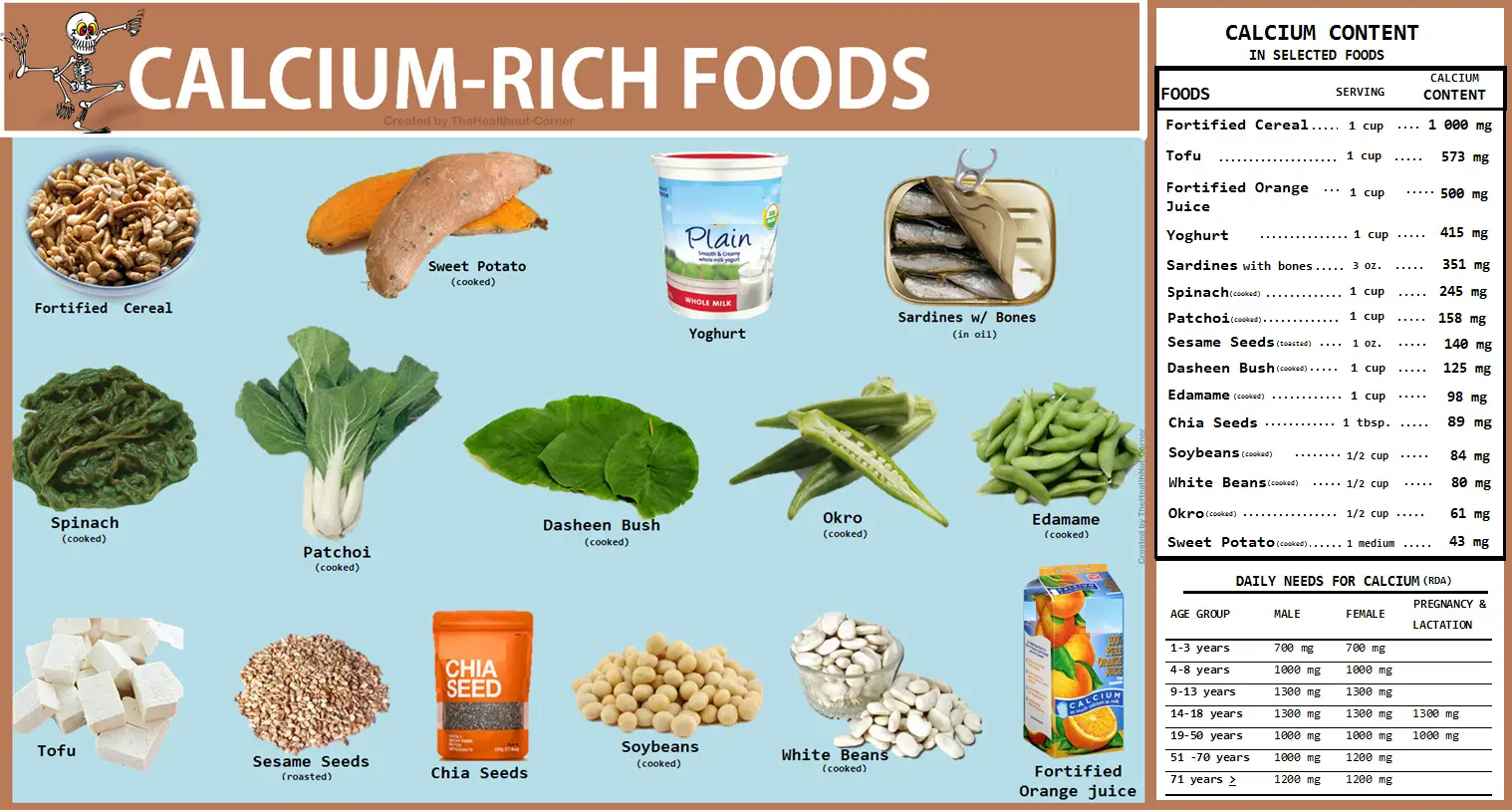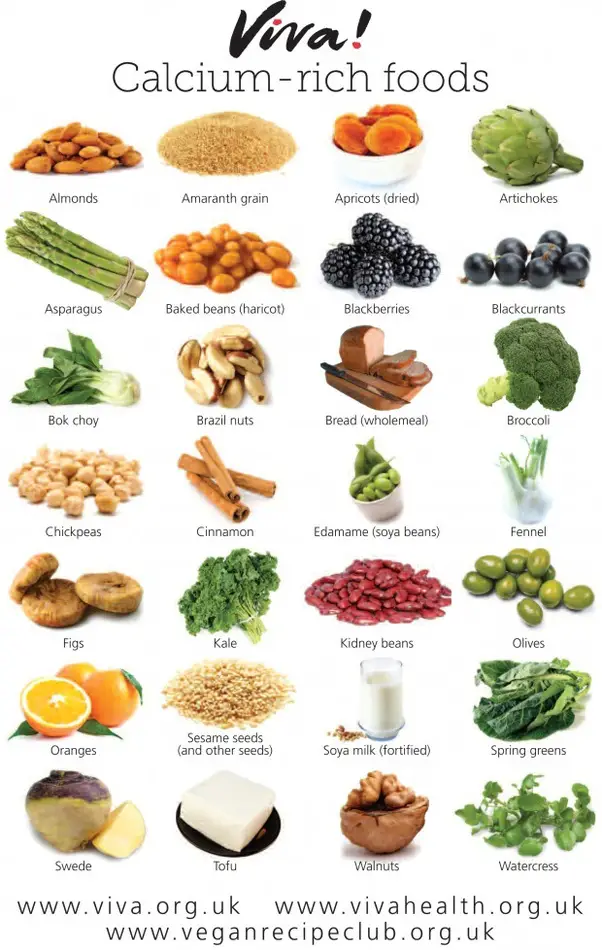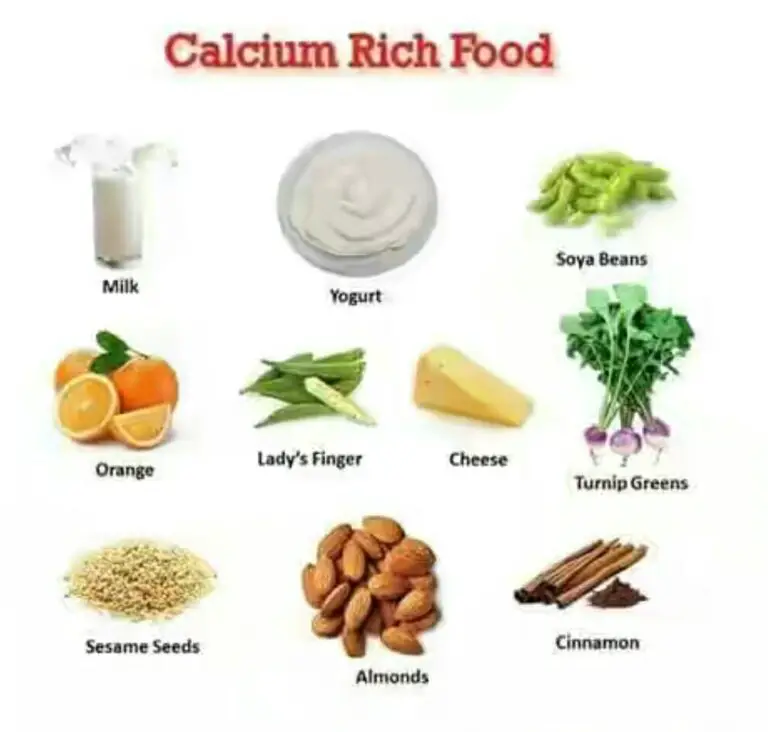What Are Vitamin D And Calcium
Vitamin D and calcium are nutrients that sustain healthy bones. They are also needed for:
-
Muscle movement
-
Absorption of calcium and phosphorous
-
Immune system responses
-
Signaling between cells
-
Hormonal secretion
-
Blood vessel flow
Without enough vitamin D or calcium, your parathyroid glands compensate by producing too much of their hormone, a condition called hyperparathyroidism. That can lead to bone weakening and increased fracture risk. Other problems from calcium and vitamin D deficiencies include:
-
Skeletal deformities in children ages 6-24 months
-
Muscle weakness in children and the elderly
Given the crucial role of both nutrients in bone health, The Endocrine Society and the Institute of Medicine recommend certain consumption levels based on age and health. They have not yet found, however, that taking vitamin D provides cardiovascular protection.
Foods With Calcium And Vitamin D To Take Care Of Your Bone Health
Taking care of bone health is important to prevent bones from weakening and being more prone to fractures. For this, it is necessary to consume foods that provide calcium, and supplement them with those that contain vitamin D, since this is responsible for making the mineral absorbed correctly.
Next, we will tell you which are those foods rich in calcium and vitamin D that could help to take care of and strengthen your bone health.
Cereal Can Be Fortified With Vitamin D And Oatmeal Offers Fiber
A packet of unsweetened, fortified oatmeal can add a solid dose of vitamin D to your diet. Ready-to-eat fortified cereal typically gives you 40 IU of vitamin D per serving, per the NIH, but it may provide more if you choose a more heavily fortified cereal, like Raisin Bran, which has 60.2 IU per cup, notes the U.S. Department of Agriculture.
Fortified cereal can be a solid base for a nutrient-rich, high-fiber meal especially if you add fortified low-fat or fat-free milk to your bowl for an extra 60 IU per half cup. Or you can be more adventurous and make a breakfast cookie that includes both fortified cereal and vitamin Dfortified margarine.
You May Like: What Is Vitamin E Oil
Vegetables And Fruit Can Provide Calcium
In addition to milk, some vegetables contain enough calcium to meet a portion of the bodys daily calcium needs. This is especially helpful for those who choose diets rich in vegetables and/or avoid dairy products. Although a good source, vegetables may not provide the total daily recommended amounts of calcium. Soy-based products, bread, fish with bones and supplements can be used to help meet the daily amount, if needed. To determine if you are getting enough calcium on a daily basis, try the Calcium Calculator put out by the Dairy Council of California.
There are numerous vegetables and fruits that contain calcium-some more than others. Many calcium-rich vegetables can be grown in Michigan. Some calcium-rich fruit can be grown in Michigan however, tropical fruit sources of calcium can still be purchased from markets.
Are Vegans Deficient In Calcium And Vitamin D

If youre eating a plant-based, highly nutritious diet, you are going to be in great shape and be the best you can be. Undermining that by not paying attention to calcium and vitamin D would be a mistake.
Its possible that given the body weight of vegans, bone density could be a little lower, but perhaps bone quality is better due to less inflammation. However, research suggests that vegans should pay more attention to these two because they are often lacking in vegan diets.
In a paper reviewing the health effects of a vegan diet, they looked at bone health in vegans. It was found that Asian women who were vegan had low spine and hip bone mass density.
They showed that the higher rates of bone fracture in vegans seem to be a consequence of them not getting enough calcium in their diet. But when vegans did get enough calcium in their diet they had no difference in fracture rate compared to omnivores.
Furthermore, EPIC-Oxford study shown that vegans had the lowest intake of vitamin D. Getting just one-fourth the amount of vitamin D that omnivores were getting through their diet.
The consequence of inadequate levels of vitamin D in vegans was shown in a study performed in Finland. Vegans having significantly lower BMD in the lumbar region of the spine, and lower BMD in the neck and femur
Given this evidence, vegans should pay more attention to these two important nutrients in the diet.
Read Also: What Is A Toxic Level Of Vitamin D For Dogs
Eat Mushrooms For A Versatile Vitamin D Punch
While mushrooms don’t naturally offer a high amount of vitamin D, some are treated with UV light, providing a larger dose of the nutrient as a result. The vitamin D amounts will vary depending on the amount of UV light the mushrooms are exposed to, according to the Agricultural Research Service. A serving has between 124 and 1,022 IU per 100 grams .
Growers such as Monterey Mushrooms produce varieties high in vitamin D, but you have to read the labels. Once you have them, add sautéed mushrooms to eggs or fish for a meal even richer in vitamin D. Or make a more substantial mushroom dish, such as veggie-stuffed portobellos.
How Much Calcium Should I Aim For And What Foods Should I Focus On
Foods rich in calcium can be found in vegetables such as broccoli and kale fortified foods such as breakfast cereals, juices, and soy foods and dairy foods such as cheese, milk, and yogurt. To help you better understand how much calcium you should be getting and how much of it is in certain foods, see the tables below.
|
Calcium recommendations |
mg/day |
|---|
|
Soy or rice milk, fortified with calcium, 1 cup |
80500 |
Also Check: What Should Be In A Prenatal Vitamin
Tuna Swordfish And Salmon Are All Good Sources Of Vitamin D
Are you getting enough vitamin D in your diet? This nutrient is important for growing healthy cells, keeping your immune system humming to ward off illness, and aiding in calcium absorption so your bones stay strong. It also helps prevent the bone disease rickets in children, and with calcium, the so-called Sunshine Vitamin can help guard against osteoporosis in older adults, the National Institutes of Health notes.
Vitamin D is produced in your body when the suns ultraviolet rays hit your skin, and the recommended daily allowance of vitamin D is 600 international units , which is 15 micrograms for most adults, according to the NIH. For those older than 80, the RDA is 800 IU .
Yet most people dont get enough vitamin D via sunlight, nor is food a good source of the nutrient, says Lori Zanini, RD, a Los Angelesbased dietitian.
People typically dont exceed 288 IU per day from diet alone. Even if you drink milk fortified with vitamin D, 8 fluid ounces has only 100 IU one-sixth the amount that you need daily. No wonder 41.6 percent of Americans have a vitamin D deficiency, per a study. A vitamin D deficiency means you have 20nanograms per milliliter or less of the nutrient in your blood. If you are nonwhite, obese, or do not have a college education, you may be at greater risk for being vitamin D deficient. Your healthcare provider can test your blood to find out for sure.
RELATED: Do You Need to Take a Vitamin D Supplement?
Fortified Orange Juice Can Give You A Healthy Start To The Day
One cup of fortified orange juice can add up to 137 IU of vitamin D to your daily total, though the NIH recommends checking the label for exact numbers because counts can vary. Serve a glass of OJ with breakfast or use it in this mango-strawberry smoothie recipe, a delicious and portable morning meal. Keep in mind that its generally healthiest to enjoy whole fruit rather than its juice form, since the former still contains filling fiber, so drink juice in moderation. If you have a health condition for which you need to watch your carbohydrate and sugar intake, such as diabetes, it may be best to get your vitamin D from another source. Work with your healthcare team to figure out how much, if any, OJ is right for your diet.
Don’t Miss: Do One A Day Vitamins Have Iron
Cooking Vegetables Can Increase The Amount Of Calcium They Can Provide
Cooking vegetables usually always increases the amount of calcium available in the vegetable for the body to absorb, and this difference can be big. For example, cooked spinach has 245 mg/cup of calcium, while raw spinach only has 30mg/cup! Keep in mind, raw vegetables can be higher in other nutrients than cooked versions . Eating a varied diet that includes both raw and cooked vegetables is a good way to ensure intake of needed nutrients.
More Mushrooms Exposed To Sunlight High In Vitamin D
- 122% DV per cup of portabella mushrooms
- 98% DV per cup of maitakes
- 92% DV per cup of white button mushrooms
- 17% DV per cup of morels
- 14% DV per cup of chantarelles
- 5% DV per cup of shiitakes
Mushrooms create vitamin D from sunlight much like our bodies. Placing any mushroom under the sun for 20 minutes will boost its vitamin D level.
You May Like: What Is The Purest Form Of Vitamin C
How Much Vitamin D And Calcium Do I Need
PHE recommends 700mg of calcium per day for men and women. As for vitamin D, the recommended daily maintenance dosage is 400IU daily as outlined in the NICE guidance. The guidance was developed to ensure that the UK population has a satisfactory level of Vitamin D throughout the year, in order to protect musculoskeletal bone health.
While most individuals should be able to get their recommended intake of vitamin D and calcium without using supplements, there are those of us who, maybe due to dietary restrictions or medical conditions, perhaps dont get enough of these minerals through the food they eat. If youre unable to meet your recommended daily intake from food, supplements can be used but ask your doctor for advice.
How The Vitamin D And Calcium Relationship Works For Bone Health & More

May 14, 2019
Vitamin D and calcium are two essential nutrients that can have a big impact on health. Although both are known for their respective health benefits, did you know that they actually work together in the body? Its true getting enough of each is equally important when it comes to bone health, weight control, cancer prevention and more. Meanwhile a calcium or vitamin D deficiency can have long-lasting effects on overall health.
So how does vitamin D affect calcium levels? How much calcium and vitamin D do I need? And can I take vitamin D without calcium? Heres what you need to know.
Also Check: How To Check Vitamin D Levels At Home
Spiced Quinoa With Salmon & Eggs
Tuna, mackerel and salmon are ideal sources of vitamin D, which is essential for bone health, the immune system and muscle function, among other things. Quinoa is the new superfood that everyone is talking about is a must-try this year if you have not already discovered it. To get you started, try this quick recipe to put a little spice into your Spring.
Ingredients
- 1 head broccoli, divided into florets
- 2 hard-boiled eggs, shelled & quartered
- 2 grated carrots
- 100g baby spinach roughly chopped
- 1 red onion, sliced
- 4Tbsp chopped fresh parsley
Method
We Have To Sort It Out
There are certain foods that take calcium from our body. On the other hand, others do not allow to assimilate it well. This is why the following foods are not recommended:
- An excess of animal protein
- Alcohol
- Fried
- Salty foods
- As for the bran, it prevents the absorption of calcium: we should therefore consume whole foods while avoiding products that contain added fibers or take them separately from foods rich in calcium.
- Vegetables with oxalates : they can also be eaten separately from foods rich in calcium
You May Like: How To Know What Vitamins I Need
Nigerian Foods Rich In Calcium And Vitamin D
Nigerian foods rich in Calcium and Vitamin D, Nigeria food for strong bone.
Things that can help boost your immunity:Getting more vitamin D
Vitamin D is essential for its ability to modulate the bodys immune response. It can also activate T cells in the body, reinforcing the bodys natural defense against viruses and infections.
Here are only a few effective ways to get more vitamin D:
Take some sunshine. 10-30 minutes of midday sunlight would be great on a regular basis and supply our bodies with vitamin D. However, if you are sensitive to sunlight, it is best to limit your exposure.
Eat foods rich in vitamin D as well as fortified foods. Some of the foods you can include in your diet at higher rates of Vit D are as follows: Seafood, Fatty fish such as tuna, mackerel, anchovies and sardines + Egg yolks.
Vitamin D rich foods in Nigeria are:
Pawpaw
What of Calcium rich Nigerian foods?
Get healthy bones with calcium rich foods!
Calcium rich foods like Kale, mustard greens, turnip greens and broccoli have a calcium absorption rate of 50-65%, which is more than milk .
Still on Nigerian foods high in calcium
It is crucial to build your bone strength and prevent heart diseases by merely incorporating these calcium-rich foods in your diet. The most abundantly-available nutrient in our body, calcium, also happens to be abundantly critical for maintaining bone strength.
The recommended daily intake of the mineral stands at 1000 mg.
Sardines And Canned Salmon
Sardines and canned salmon are loaded with calcium, thanks to their edible bones.
A 3.75-ounce can of sardines packs 35% of the RDI, and 3 ounces of canned salmon with bones have 21% .
These oily fish also provide high-quality protein and omega-3 fatty acids, which are good for your heart, brain and skin .
While seafood can contain mercury, smaller fish such as sardines have low levels. In addition, both sardines and salmon have high levels of selenium, a mineral that can prevent and reverse mercury toxicity .
Summary
Sardines and canned salmon are exceptionally healthy choices. A can of sardines gives you 35% of the RDI for calcium, while 3 ounces of canned salmon packs 21%.
Don’t Miss: What Is Natural Vitamin C
Reading Food Labels How Much Calcium Am I Getting
To determine how much calcium is in a particular food, check the nutrition facts panel for the daily value . Food labels list calcium as a percentage of the DV. This amount is based on 1,000 mg of calcium per day. For example:
- 30% DV of calcium equals 300 mg of calcium.
- 20% DV of calcium equals 200 mg of calcium.
- 15% DV of calcium equals 150 mg of calcium.
Canned Fish Sardines And Salmon
Amount of calcium per average portion size:
- 50g sardines 200mg
- 105g tinned pink salmon 100mg
Find more sardine recipes.Canned fish is a useful storecupboard addition and increases your calcium intake too. Thrifty sardines are great in pasta dishes or on toast, while tinned salmon is delicious in salads or quick & easy fishcakes.
You May Like: Where Can I Get Vitamin C Powder
What Research Gaps Were Identified
The IOM expert committee identified areas where further research would help improve the determination of reference values in the future. A total of 22 major research needs were identified and are summarized in Table 9-1 of the report. The general categories of information gaps are:
- Data on the physiology and metabolism of calcium and vitamin D
- Data on health outcomes and adverse effects related to calcium and vitamin D
- Data on dose-response relationships between intakes of calcium and vitamin D and health outcomes
- Evidence to judge independent effects of calcium and vitamin D
- Information on the impact and role of sun exposure relative to vitamin D
- Standardized and consistent data on calcium and vitamin D intakes
- Exploration of methodologies for synthesizing evidence
How Do You Get Vitamin D And Calcium

Your body makes Vitamin D when your skin is exposed to sun, but several factors limit its creation:
-
Living anywhere in the country above latitude 33 degrees
-
Wearing sunscreen to protect against melanoma
-
Having naturally dark skin
-
Aging, which changes absorption ability
-
The amount of sun you would need to achieve normal blood vitamin D levels is probably more than is safe for your skin, so most people may need supplements to achieve a normal vitamin D level.
Either form of vitamin D benefits the body, but very few foods naturally contain the nutrient or are fortified with it. Thats why doctors recommend supplements to make up the difference. Foods containing vitamin D include:
-
Cod liver oil: 400-1,000 IU per teaspoon
-
Wild caught salmon: 600-1,000 IU per 3.5 oz
-
Farmed salmon: 100-250 IU per 3.5 oz
-
Canned salmon: 300-600 IU per 3.5 oz
-
Canned sardines: 300 IU per 3.5 oz
-
Canned mackerel: 250 IU per 3.5 oz
-
Canned tuna: 236 IU per 3.5 oz
-
Fresh shitake mushrooms: 100 IU per 3.5 oz
-
Sundried shitake mushrooms: 1,600 IU per 3.5 oz
-
Egg yolk: 20 IU per yolk
Milk, orange juice, infant formula, yogurt, margarine, butter, cheese and breakfast cereals are often fortified with vitamin D.
Calcium is found in:
Also Check: Is Vitamin C Hard On Your Kidneys